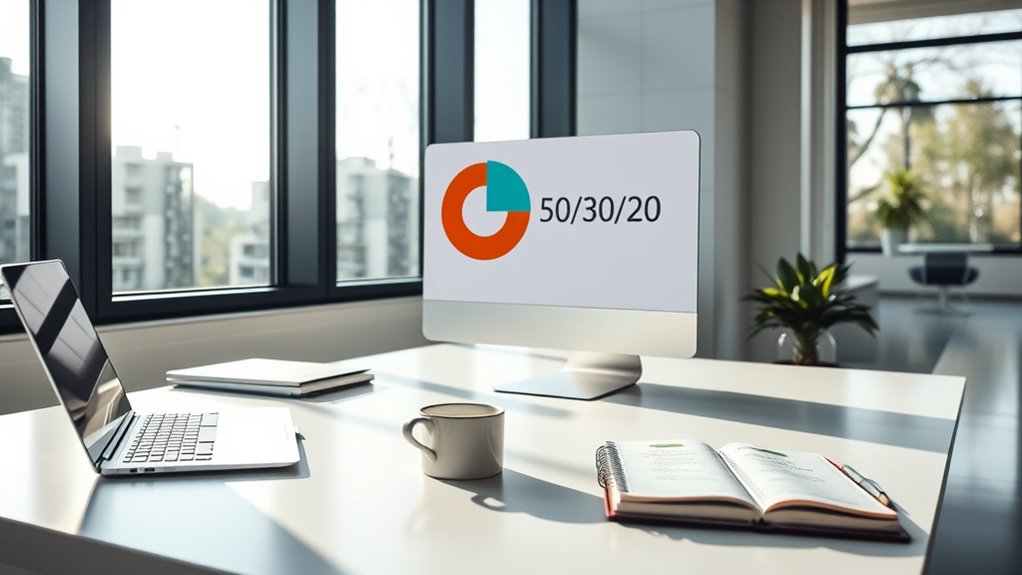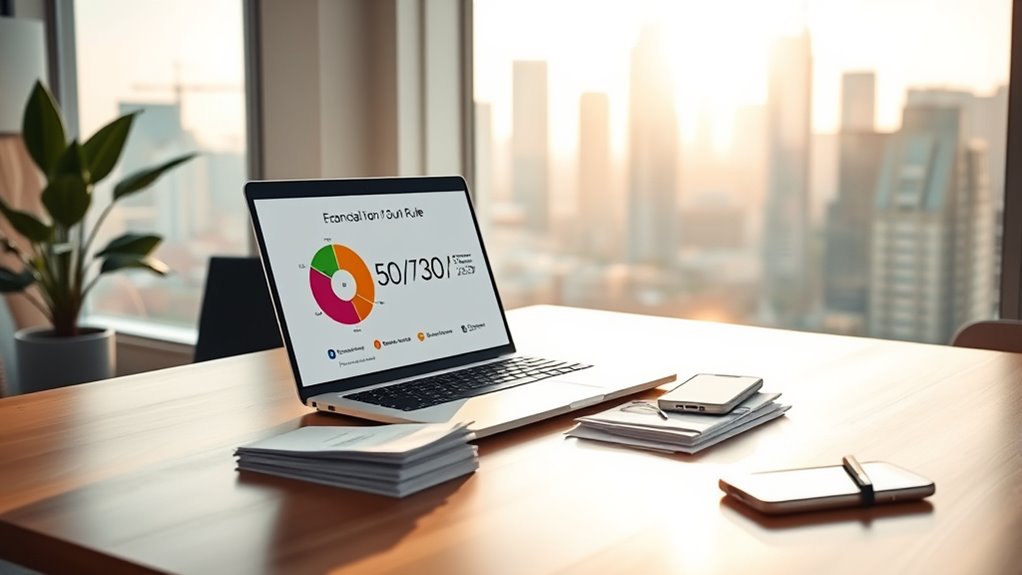The 50/30/20 rule remains relevant in 2025 as a simple, adaptable budgeting guideline. It helps you manage your finances by dividing after-tax income into needs, wants, and savings or debt repayment. Despite economic shifts like inflation, you can adjust these percentages and use digital tools to stay on track. Staying flexible allows the rule to support your financial goals in any economic climate. Keep exploring to learn how to optimize this framework for your situation.
Key Takeaways
- The 50/30/20 rule remains a simple, adaptable framework for balancing needs, wants, and savings, suitable for evolving economic conditions.
- In 2025, rising inflation requires adjusting percentage allocations and leveraging digital tools for effective budget management.
- Digital banking enhances real-time expense tracking and automation, supporting the rule’s flexibility amid economic shifts.
- Customizing categories and goals ensures the rule stays relevant for personal financial priorities in changing financial landscapes.
- Overall, the 50/30/20 rule continues to be a practical guideline for financial discipline and long-term stability in 2025.
The Origins and Core Principles of the 50/30/20 Rule

The 50/30/20 rule originated as a simple budgeting guideline designed to help individuals manage their finances effectively. Its core principle divides your after-tax income into three categories: 50% for needs, 30% for wants, and 20% for savings and debt repayment. This straightforward approach encourages disciplined spending and prioritizes financial goals like retirement planning. By allocating a portion of your income toward investment allocation, you can build wealth over time without overcomplicating your budget. Although initially focused on day-to-day expenses, the 50/30/20 rule also emphasizes the importance of saving consistently, which is essential for long-term financial stability. Its simplicity makes it adaptable, helping you balance current expenses with future financial security.
How Economic Changes in 2025 Affect Budgeting Strategies

In 2025, ongoing economic shifts are reshaping how you should approach budgeting. The inflation impact remains significant, making it essential to adjust your spending habits and savings to keep up with rising prices. Higher inflation means your purchasing power could decline if you don’t adapt, so tracking expenses becomes more critical. Digital banking tools simplify this process, allowing you to monitor your finances in real-time and set automated alerts for overspending. These tools also help you stay updated on inflation trends, guiding your budget adjustments. As the economy evolves, embracing digital banking can help you maintain financial flexibility, ensuring your 50/30/20 strategy remains effective despite economic fluctuations. Staying aware and adaptable is key to sustainable financial health in 2025. Additionally, understanding specific tuning techniques for your vehicle can improve your driving experience and vehicle performance even during economic challenges.
Adapting the 50/30/20 Framework for Modern Financial Goals

As your financial goals evolve in response to changing economic conditions, adapting the 50/30/20 framework becomes essential for staying on track. With digital budgeting tools, you can easily customize your spending categories to reflect current priorities, such as increasing savings or managing credit more effectively. Incorporate credit management strategies by monitoring your credit scores and paying down debt within your budget, ensuring your financial health improves over time. Color accuracy is also important when considering how you allocate funds for home entertainment and technology upgrades, ensuring you get the best value and quality for your investment. Flexibility is key—adjust percentages as needed to accommodate shifts in income or expenses. Modern financial goals often involve balancing short-term needs with long-term ambitions, and digital tools make it easier to track progress and stay disciplined. By tailoring the framework, you can maintain control and pursue your evolving financial objectives confidently.
Frequently Asked Questions
How Flexible Is the 50/30/20 Rule During Economic Downturns?
During economic downturns, you can adapt the 50/30/20 rule to enhance your financial flexibility and boost your economic resilience. You might cut back on discretionary expenses or temporarily reduce savings to manage cash flow. While the rule offers a solid framework, staying flexible allows you to prioritize essential needs and build a safety net, helping you navigate tough times more effectively without compromising your long-term financial goals.
Can the Rule Be Adjusted for High-Income or Low-Income Households?
Imagine a tailor adjusting a suit to fit your unique shape. You can tweak the 50/30/20 rule for high-income households by including luxury expenses, ensuring they don’t overshadow savings or debt management. For low-income households, tighten the budget, focusing more on essentials and debt repayment. Flexibility helps you optimize your financial wardrobe, making sure each piece — spending, saving, debt — fits your income and goals perfectly.
Does the Rule Account for Saving for Retirement or Education?
The 50/30/20 rule doesn’t explicitly allocate funds for retirement savings or education funding, but you can adapt it. You should set aside part of your income for retirement to guarantee long-term security, and allocate some for education expenses if needed. Adjust your budget by increasing savings in these areas while maintaining balanced spending in essentials and discretionary items. This way, your financial plan remains flexible and thorough.
How Does Inflation Impact the Allocation Percentages Over Time?
You might think inflation doesn’t affect your budget, but it does. Inflation adjustment can erode your purchasing power, forcing you to reconsider your spending flexibility. As prices rise, sticking rigidly to the original allocation percentages can become tricky, so it’s wise to review and modify your budget regularly. This way, you ensure your financial plan stays realistic and sustainable despite inflation’s impact over time.
Is the 50/30/20 Rule Suitable for Self-Employed Individuals?
As a self-employed individual, you can adapt the 50/30/20 rule for freelancer budgeting and managing your employment finances. It provides a solid framework, but you might need to tweak percentages to account for variable income and irregular expenses. Flexibility is key; focus on tracking your cash flow, setting aside taxes, and saving for lean months. Customizing this rule helps you maintain financial stability while growing your freelance career.
Conclusion
The 50/30/20 rule remains a powerful tool, even in 2025, helping you stay grounded amidst economic chaos. While it’s not a perfect blueprint, adapting it to your unique goals keeps your financial journey on track. Remember, blindly following any rule won’t save you—only your discipline and flexibility will. Think of this rule as your financial compass in a stormy sea; without it, you might be lost in the chaos of modern money management.









